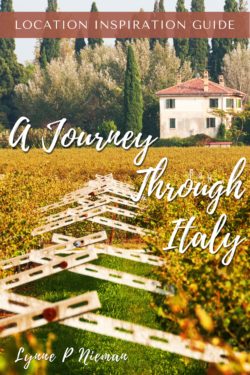Italy has 51 UNESCO World Heritage sites. This is more than other country. What is UNESCO?
The United Nations Educational, Scientific and Cultural Organization decides what sites are put onto this list. Countries submit. The organization researches. Then a decision is made. These sites can be cultural or natural.
It’s a big deal to be on this list. And Italy has so many incredible places on the list. You can’t go wrong visiting any of them. From the historic center of Florence to the archeological areas of Pompeii to the Aeolian Islands off the coast of Sicily. The Italian UNESCO sites are diverse.
I’ve selected a few that I’ve been to and highly recommend. And I’ve selected a few that are on my “want to see” list. Let’s get started.
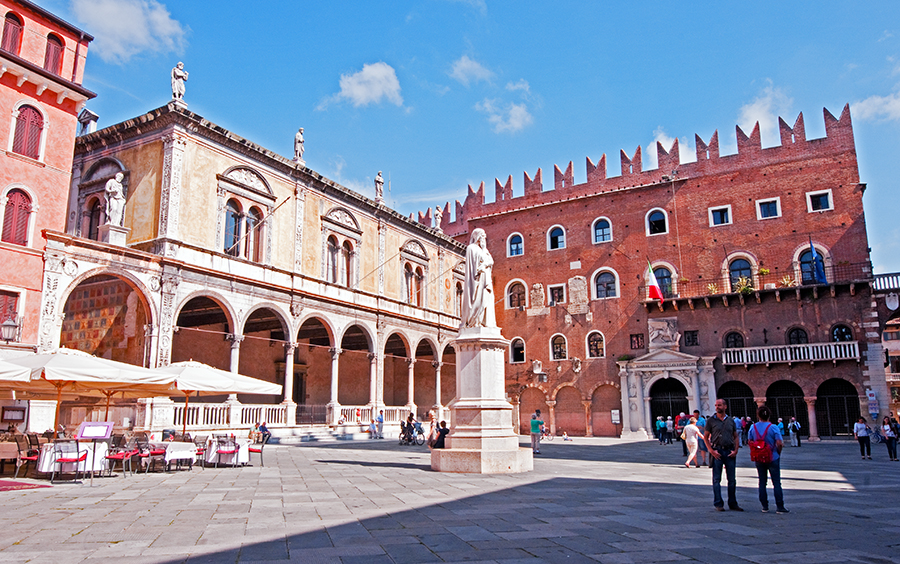
Piazza dei Signori, Verona
Sites on my “want to see” list
Trulli of Alberobello
Down in the heel of the boot, in the Apulia region (Puglia) lies the Valle d’Itria. There are loads of olive groves here as well as trulli. What are trulli? I’m glad you asked.
Trulli, trullo in singular, are round whitewashed buildings with grey conical roofs. They’re really cool and definitely hard to miss.
The trulli are unique to Puglia and their history is fuzzy. There’s speculation that they are connected to feudal lords. See the trulli are made without mortar so, as a result, would be easy to take down should the tax inspectors come around. Sneaky, right?
Most trulli are small with just a single room. They stay warm in winter and cool in summer. They were probably used as places to store food as well as to live in. Today they’re über popular as holiday homes and vacation rentals.
Alberobello is the town where you’ll see the greatest concentration of trulli and the portion that is listed on the UNESCO World Heritage list. However, you’ll find more trulli in Locorotondo, Cisternino and Martina Franca. And the Puglia region is one of the regions in Italy that is becoming more and more popular with travelers.
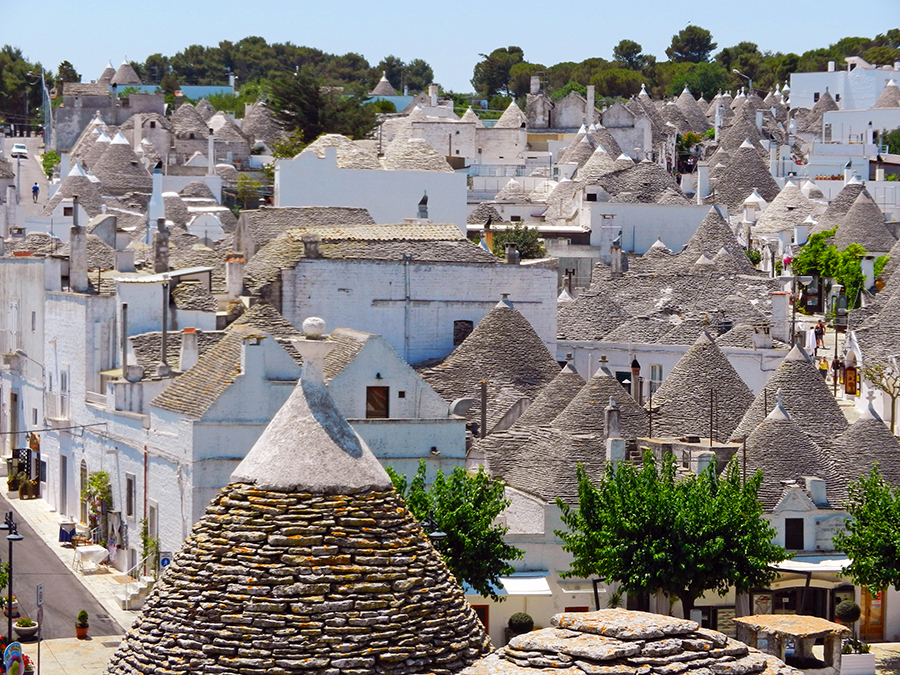
The trulli of Alberobello. Photo courtesy of Pixaby.
Residences of the Royal House of Savoy
There are roughly 13 castles, villas and palaces scattered about the Piedmont region (Piemonte) that belonged to the Savoy family at one time.
The Savoy are one of the oldest royal families in the world dating back to around 1003. The original region consisted of the territory of the western Alps between Lake Geneva in the north and Dauphiné in the south. Today this area is considered the Rhône Alps of France. But they Savoy family pushed into northern Italy. And with that, came some gorgeous palaces and castles in the area.
Three of these residences are right in Turin, Torino. And a few others are just outside of town. The rest are scattered about Piedmont.
Palazzina di Caccia di Stupinigi is known as the hunting residence. It’s no cabin the woods! It lies about 10km southwest of Torino. It’s a stunner on a large piece of land. This is the one you don’t want to miss!
Castello del Valentino is located on the outskirts of Turin. It’s another gorgeous building that is now part of the Polytechnic University of Turin.
The last one that I’ll mention is Villa della Regina which also sits in Torino. This was originally built as a private villa with its own vineyard. Where do I get one of these? It has a dazzling pool with a fountain surrounded by statues. It’s quite grand!
Vineyard Landscape of Piedmont: Langhe-Roero and Monferrato
Way high on my Italian “must see list” are the vineyards of Piedmont. This UNESCO site covers 6 distinct growing regions of Piedmont.
Why here? Well, this is the home of some of the best wine in Italy — and the world. Barolo, the so-called king of wines, is grown and created here. Barbera and Barberesco are also made here. This is the place to come if you enjoy good wine.
The landscape is gorgeous. Towns such as La Morra, Alba, Barolo, and Asti sit up on vine-covered hills. The snow-capped peaks of the Italian Alps loom off in the distance. Grinzane Cavour Castle lords over the Langhe region.
Add in the prized white truffle and an incredibly rich history of wine growing and you have the perfect destination. Well, that’s my opinion (for what it’s worth).
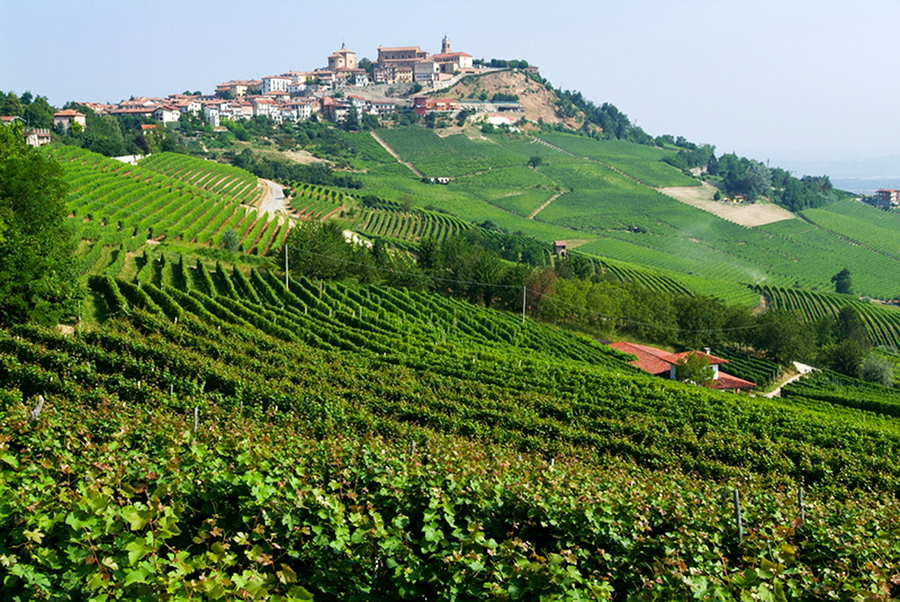
La Morra and the vineyards of Piedmont. ©Stefano Ember
Sites I’ve visited and highly recommend
City of Verona
This is a gorgeous city and one that often gets overlooked as many folks will head to Venice to the east or Milan to the west. But having been here, it’s a place I’d highly recommend. And a destination I would love to go back to.
There are loads of Roman sites, beautiful churches, and fabulous streets and piazze made for wandering. The food is delicious as well. What I liked is that it had a more down to earth feel to it compared to Venice. As I walked around, I noticed more locals simply living life.
My favorite place has to the Roman Arena. It’s a magical place. In summer, the opera festival takes place. I was fortunate to see a very famous Italian pop singer by the name of Laura Pausini there. It was an evening I won’t forget. Me and thousands of Italians. Them singing their hearts out along with Laura and me with my eyes wide, my jaw on the ground, tears in my eyes as I felt so much a part of Italian life that night.
The Piazza Brà which surrounds the Arena is a wonderful spot to sit and people watch with an espresso or a glass of vino. There are shops and cafés around as well as a park with a lovely fountain.
There are some lively pedestrian ways filled with restaurants, cafés and shops. You’ll want to check out Piazza Erbe which used to be the site of the forum. It’s still very much the heart of the city with a daily market that sells souvenirs, clothing and fast food. But, trust me, you’re not coming here for the market, you come here for the eclectic buildings that surround the piazza.
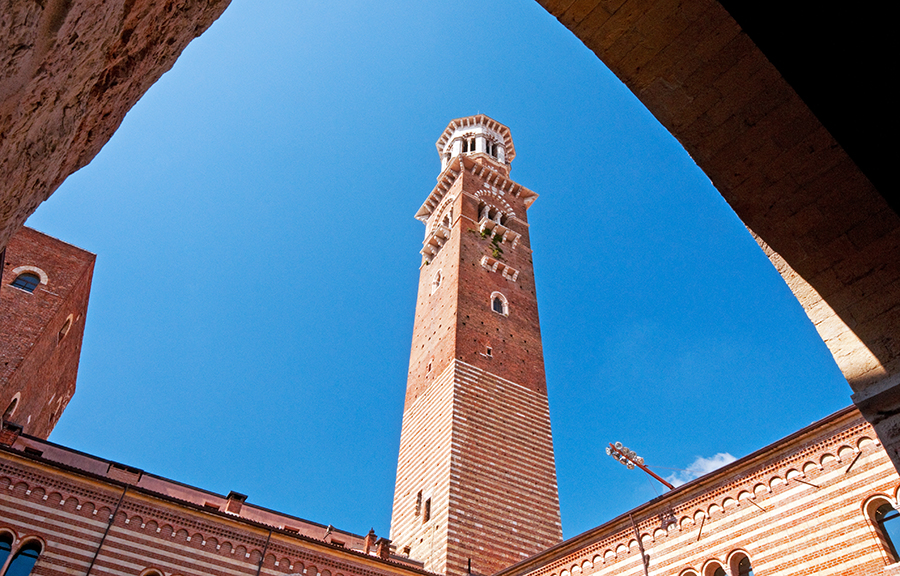
Looking up at Torre dei Lamberti, Verona
One of the places I highly recommend is a two-fer. The Piazza dei Signori is truly lovely. It’s quieter than the other two piazze so if you need a break from crowds, this is the place to be. From Piazza dei Signori you can make your way to Torre dei Lamberti and climb the 368 steps to the top for about €6. There’s an elevator that takes you about two-thirds of the way there so you don’t have to walk them all! The views of Verona and the Adige River are fab!
The other stop I suggest is to Sant’Anastasia, Verona’s largest church. And it’s a stunner. It’s mostly Gothic, but has some underlying Romanesque style. It was completed around 1481. If you visit one church in Verona this has to be it.
This is the tip of the iceberg to Verona. It’s a city worthy of a few days for sure. I didn’t even mention Casa di Giulietta or the Duomo!
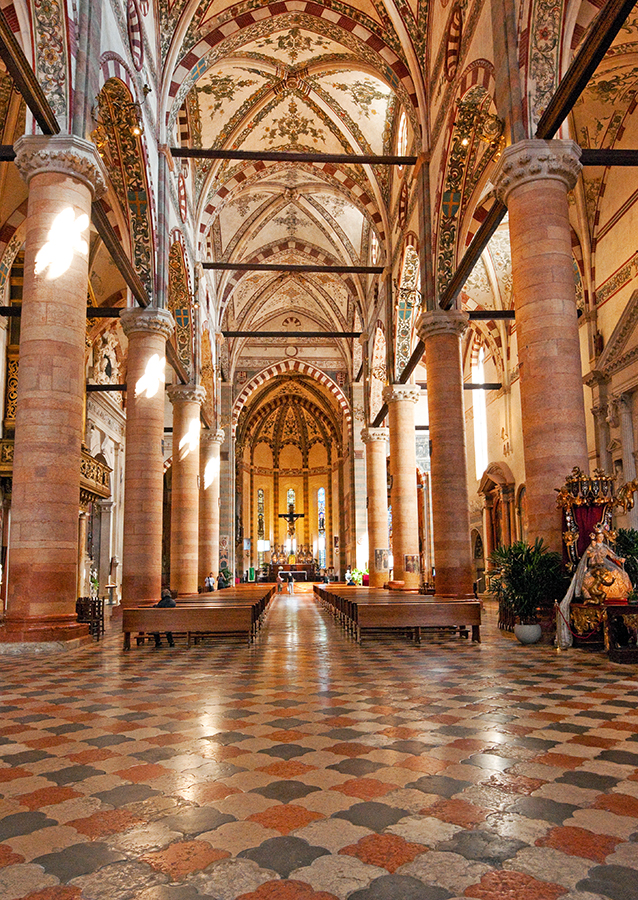
Interior of Sant’Anastasia Church, Verona
Val d’Orcia
This is the Tuscany, Toscana, of my dreams. And probably of yours too.
The Val d’Orcia is the valley that sits around the hill towns of Montepulciano, Pienza, and Montalcino. It’s agricultural land dotted with towns and villages, abbeys, farmhouses, and the occasional vineyard and olive grove.
To me, it embodies Tuscany. You’ll find lots of pieces of the Renaissance here in the architecture, the art, and the town layouts themselves — each town with a lovely piazza near the main church.
The landscape consists of gently rolling hills dotted with farmhouses, olive groves and vineyards with some dense forests of beech and chestnut trees. And, of course, the famous cypress trees line dirt roads leading to houses sitting in the middle of nowhere.
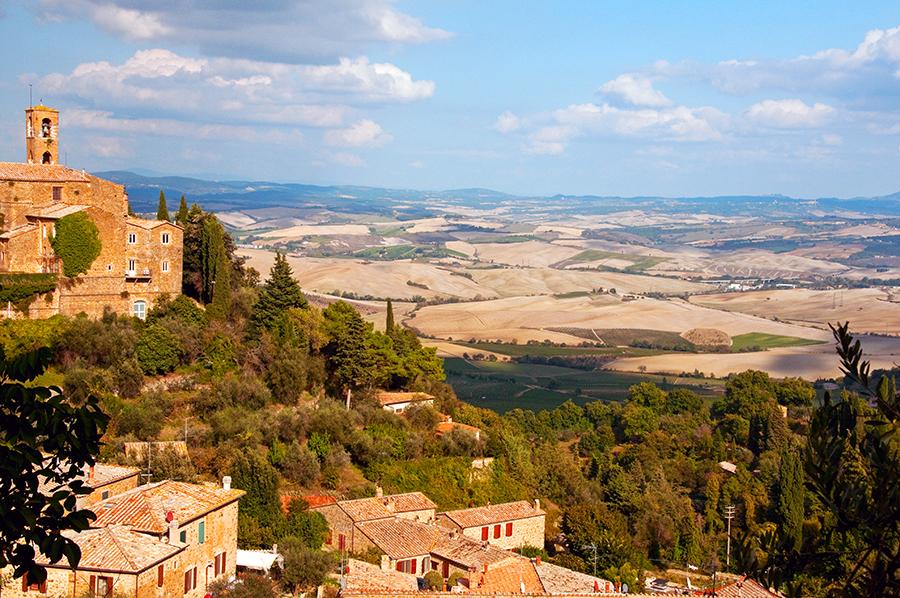
Val d’Orcia near Montalcino
There are some mountains here as well with Monte Amiata and Monte Radicofani being 2 of the bigger ones. There’s an interesting geology here in the Val d’Orcia.
But most of us come here to relax into that pastoral pace of life. We eat the fresh, scrumptious food that grows here. We drink the delicious wines that are made here. And we feel at peace in this corner of Toscana.
Dolomites
Yeah, you weren’t getting out of this post without some mountain time.
One of 4 natural World Heritage sites in Italy, this is my favorite.
Now, the Dolomites are on the list for their unique geology.
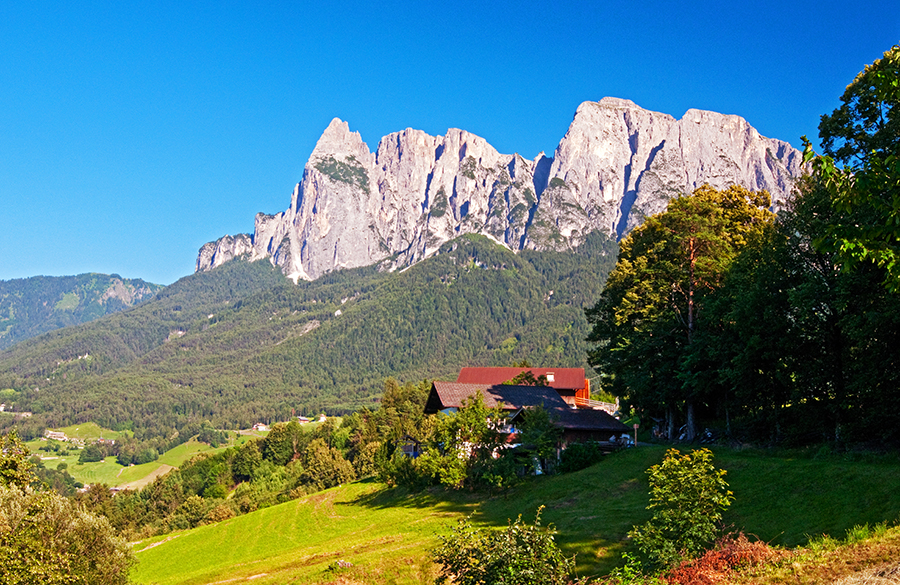
The Schlern/Sciliar of the Dolomites, near the town of Kastelruth/Castelrotto
UNESCO says this about the Dolomiti:
The quantity and concentration of highly varied limestone formations is extraordinary in a global context, whilst the superbly exposed geology provides an insight into the recovery of marine life in the Triassic period … The Dolomites are widely regarded as being among the most attractive mountain landscapes in the world. Their intrinsic beauty derives from a variety of spectacular vertical forms such as pinnacles, spires and towers, with contrasting horizontal surfaces including ledges, crags and plateaux, all of which rise abruptly above extensive talus deposits and more gentle foothills. A great diversity of colours is provided by the contrasts between the bare pale-coloured rock surfaces and the forests and meadows below. The mountains rise as peaks with intervening ravines, in some places standing isolated but in others forming sweeping panoramas. Some of the rock cliffs here rise more than 1,500 m and are among the highest limestone walls found anywhere in the world.
There are 9 Dolomiti parks most of which are in the Trentino-Alto Adige region, but there are a couple that are either completely or partly in the Veneto and Friuli-Venezia Giulia.
You all know I’m a mountain gal having lived for 15 years in Colorado. I’ve seen some stunning landscapes in my old home state as well as in Utah and Wyoming (the Tetons are gorgeous).
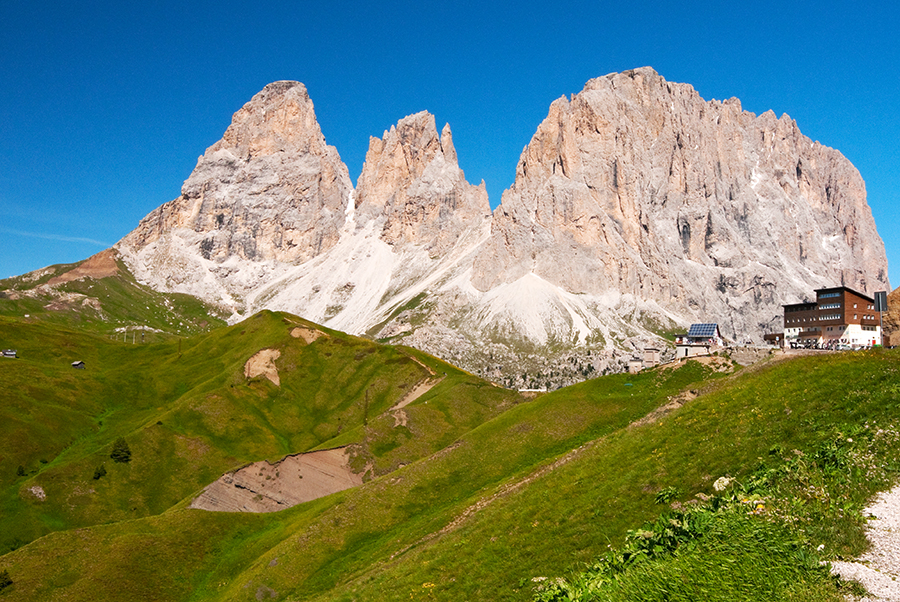
Dolomites of the Val Gardena
But the Dolomites? I was blown away by these peaks the first time I saw them. And then again and again. There really is nothing quite like them. These dazzling peaks deserve their UNESCO designation.
And you don’t have to be some hardcore hiker or mountaineer to enjoy them. You can take lovely drives. You can hop aboard a gondola or ski lift and get up in there. Of course, hiking will get you further into the mountains and up a bit higher. I can’t recommend the Dolomites enough. What can I say? I’m in love…
If you love Italy, be sure to check out my new e-book. Location Inspiration Guide: A Journey Through Italy.


